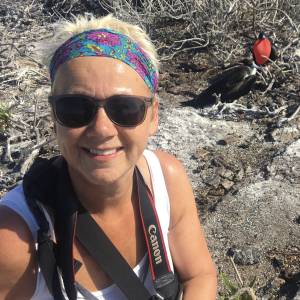We wake refreshed, thrilled to see the sun shining across the bay and over to our deck - though the coolness of the air temperature means we still breakfast inside.
Today we plan to visit all those places yesterday’s rain prevented, and we set out with enthusiasm for Cathedral Caves. Inaccessible for all but two hours either side of low tide, visits need to be carefully arranged; access is across Māori land, and gated shut when the tide’s too high to venture across the beach. Our research has paid dividends; the gate is open, and having bought our ticket, we make the 30 minute hike through rainforest to the sands, sunlight percolating through the canopy to beautiful effect.
We reach the glorious beach where the caves stand - the turquoise breakers bright against the sun and contrasting with the ominously dark sky still in the distance, the vastness reminiscent of Hebridean landscapes. We’re far from alone - but thankfully the school group visiting ahead of us are just about to finish, so we’re left with couples and small groups.
True to their name, the caves are certainly cathedral like in stature, but for me the most interesting thing is their openings onto the sea and sand, the colours beautiful against their dark interiors, with silhouettes of people stark against the brightness.
The tide is encroaching to the entrances with speed, and typicality, as we return, the heavens open and our whole return is trudged through rain - though at least the forest canopy cuts out the worst.
Next on our list is also tide dependent - the petrified forest at Curio Bay - a rock platform exposed at low tide where the petrified logs and stumps of forests destroyed some 180 million years ago lie long embedded (more details in the link below).
https://www.bbc.com/travel/article/20211111-new-zealands-180-million-year-old-forest
By now the rain has almost stopped, but it’s very blustery and damp - and also distinctly chilly; The Catlins is definitely the coldest area we have visited on our New Zealand trip with temperatures today frequent,y below 10C. But this does nothing to detract from this rarest of treats - the fascinating sight of these ancient tree trunks turned to stone, yet with their bark and grain and texture perfectly preserved. Even without this geological wonder, this rock platform itself is stunning, washed by the wind and tides and garlanded with colour from seaweed necklaces in gold and orange and green.
This is another area famed for wildlife - particularly those yellow-eyed penguins - but we know that a February afternoon is not the time we’re likely to see them, so take advantage of the cafe instead.
Two destinations ticked off, I’m now keen to do a wetland board walk - which we do, walking first through native forest thick with the calls of Tui and the heavy wingbeats of kereru (New Zealand pigeon) as these large plump iridescent birds fly overhead. Out on the board walk, the view is beautiful - though I only manage to see a white faced heron fishing.
By now, we’re tiring, so there’s just one more Catlin treasure in our list - the purakaunii falls. Framed by more beautiful native forest, they cascade 20 metres over 3 tiers - and are apparently amongst the most photographed waterfalls in New Zealand. It’s another short walk through forest and birdsong, the sun piercing through the canopy and adding floodlit greens and golds.
Whilst there are other waterfalls and walks we’ve missed, we feel we e gone some way to doing justice to our short stay in this delightful corner, so we return to base for a relaxing evening enjoying dinner with our epic views. Tomorrow we embark on the final four days of our trip ….
My main today’s Cathedral Caves - silhouettes minus G this time, with extras of the waterfall, the petrified trunks and stumps at Curio Bay, a seaweed collage and some spindrift.

Comments
Sign in or get an account to comment.


